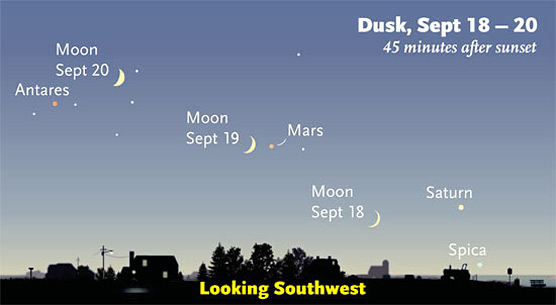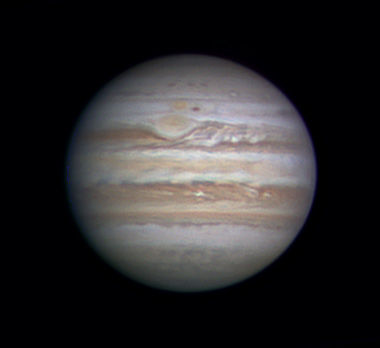Some night sky sights for September 14 – 22
Friday, Sept. 14
Saturday, Sept. 15
Sunday, Sept. 16
Monday, Sept. 17

Watch the Moon wax past Saturn, Mars, and Antares day by day. Note: the visibility of faint objects in bright twilight is exaggerated here. (This scene is plotted for the middle of North America. European skywatchers: move each Moon symbol a quarter of the way toward the one for the previous date. The Moon is shown three times actual size.)
Sky & Telescope diagram
.
Tuesday, Sept. 18
Wednesday, Sept. 19
Thursday, Sept. 20
Friday, Sept. 21
Saturday, Sept. 22
Want to become a better amateur astronomer? Learn your way around the constellations. They're the key to locating everything fainter and deeper to hunt with binoculars or a telescope.
For an easy-to-use constellation guide covering the whole evening sky, use the big monthly map in the center of each issue of Sky & Telescope, the essential guide to astronomy. Or download our free Getting Started in Astronomy booklet (which only has bimonthly maps).
Sky Atlas 2000.0 (the color Deluxe Edition is shown here) plots 81,312 stars to magnitude 8.5. That includes most of the stars that you can see in a good finderscope, and typically one or two stars that will fall within a 50× telescope's field of view wherever you point. About 2,700 deep-sky objects to hunt are plotted among the stars.
Alan MacRobert
Once you get a telescope, to put it to good use you'll need a detailed, large-scale sky atlas (set of charts). The standards are the little Pocket Sky Atlas, which shows stars to magnitude 7.6; the larger and deeper Sky Atlas 2000.0 (stars to magnitude 8.5); and the even larger Uranometria 2000.0 (stars to magnitude 9.75). And read how to use sky charts with a telescope effectively.
You'll also want a good deep-sky guidebook, such as Sue French's Deep-Sky Wonders collection (which includes its own charts), Sky Atlas 2000.0 Companion by Strong and Sinnott, the bigger Night Sky Observer's Guide by Kepple and Sanner, or the classic if dated Burnham's Celestial Handbook.
Can a computerized telescope replace charts? I don't think so — not for beginners, anyway, and especially not on mounts and tripods that are less than top-quality mechanically (able to point with better than 0.2° repeatability). As Terence Dickinson and Alan Dyer say in their invaluable Backyard Astronomer's Guide, "A full appreciation of the universe cannot come without developing the skills to find things in the sky and understanding how the sky works. This knowledge comes only by spending time under the stars with star maps in hand."
This Week's Planet Roundup
Mercury is hidden deep in the sunset.
Venus (magnitude –4.2, crossing Cancer) rises in darkness around 3 a.m. daylight saving time (depending on where you live), emerging above the east-northeast horizon two hours before the first glimmer of dawn. By dawn it's blazing high in the east.
Binoculars show the Beehive star cluster about 3° above Venus on the morning of the 15th, widening to 10° by the 22nd.
Mars and Saturn (magnitudes +1.2 and +0.8) are low in the southwest and west-southwest, respectively, after sunset. They're now about 20° apart. Use binoculars to help find them in early twilight before they sink too low.
Mars begins the week just 1° below Alpha Librae, a wide binocular double star of magnitudes 3 and 5. By Tuesday September 18th, Mars is 2½° left of the star pair.

Jupiter's Great Red Spot had recently crossed the planet's central meridian when S&T's Sean Walker took this image on the morning of September 13th. South is up. Note that ring-like Red Spot Junior (Oval BA) is now passing just south of the Great Red Spot with no apparent effect on either of them. Walker used a 12.5-inch Newtonian telescope with a DMK 21AU618 astro video camera.
See our article Big Breakout on Jupiter on the dramatic growth this year of the North Equatorial Belt (below center here).
S&T: Sean Walker
Jupiter (magnitude –2.4, in Taurus) rises in the east-northeast around 11 p.m. daylight saving time. Once it's clear of the horizon, look for fainter orange Aldebaran twinkling 7° or 8° to its right, and Beta Tauri slightly farther to Jupiter's left. By the beginning of dawn, this lineup-of-three stands high and diagonal in the south.
Uranus (magnitude 5.7, at the Pisces-Cetus border) and Neptune (magnitude 7.8, in Aquarius) reach good heights in the southeast by mid-evening.
Throughout late September Uranus is passing very close to the similarly bright, but differently colored, star 44 Piscium; see our article Uranus's Rare Close Encounter. And here are finder charts for Uranus and Neptune for the rest of the year.
All descriptions that relate to your horizon — including the words up, down, right, and left — are written for the world's mid-northern latitudes. Descriptions that also depend on longitude (mainly Moon positions) are for North America. Eastern Daylight Time (EDT) equals Universal Time (also known as UT, UTC, or GMT) minus 4 hours.
Like This Week's Sky at a Glance? Watch our weekly SkyWeek TV short. It's also playing on PBS!
To be sure to get the current Sky at a Glance, bookmark this URL:
http://SkyandTelescope.com/observing/ataglance?1=1
If pictures fail to load, refresh the page. If they still fail to load, change the 1 at the end of the URL to any other character and try again.
 0
0
Comments
You must be logged in to post a comment.